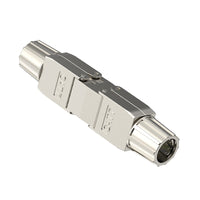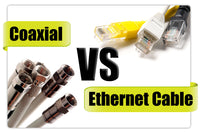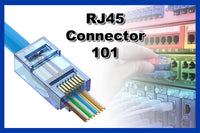Are you going to install network outside to connect two of your buildings? Do you plan to install an outdoor Wi-Fi access point? Running an Ethernet cable outside is very necessary for various applications. Most Ethernet cables are used indoors, but there are also specified cables for outdoor applications.
In general, an ordinary Ethernet cable can be easily prone to broken outdoors. Don’t you find it difficult to choose a correct outdoor Ethernet cable? We’ll dive into everything about outdoor Ethernet cable in this article.
What is Outdoor Ethernet Cable?
Outdoor Ethernet cables are commonly used for various outdoor environments. They are designed to withstand extreme weather, so these Ethernet cables are more robust and durable than ordinary Ethernet cables. In addition, most Ethernet cables used outside are shielded for stable data transmission.
Indoor Ethernet Cable vs. Outdoor Ethernet Cable
You can differentiate indoor Ethernet cables from outdoor Ethernet cables by their jacket color as the latter often features a black jacket, but it cannot always work. The largest difference between indoor and outdoor Ethernet cables is their cable jacket.
Indoor Ethernet cables are generally designed to run through walls and ceiling, so their outer jacket is usually made of less thick material for enough flexibility. Indoor Ethernet cables are generally used for short-distance applications and most of them cannot be used outside.
Outdoor Ethernet cables are made of thick plastic so that they can be installed outside the building to withstand extreme weather conditions. Outdoor Ethernet cables are installed above or underground for a long distance.

How to Select the Correct Outdoor Ethernet Cable?
4 Factors Considered Before Selecting
Before selecting the outdoor Ethernet cable, you should take the outdoor weather conditions into consideration. A good-quality outdoor Ethernet cable should withstand low or high temperature, sunlight, moisture, and lighting.
- Temperature: A temperature rating is very essential for an outdoor Ethernet cable as too low or high temperature can make an ordinary Ethernet cable easily brittled or cracked and speed up the aging of a cable. Manufacturers generally indicate operation and installation temperature on the Ethernet cable specification. The ideal operating temperature of an Ethernet cable running outside can be -40-75 °C.
- Sunlight: The UV spectrum of the sunlight can largely damage the cable jacket , so outdoor Ethernet cables should be resistant to UV.
- Moisture: The rain and moisture can penetrate into the cable and affect the data transmission if the cable jacket is fragile. Properly formulated PE plastic is an ideal material to withstand rain and moisture.
-
Lighting: Lighting is unavoidable in the running of an outdoor Ethernet cable, and lighting surge protection is necessary, but a thick Ethernet cable can be better.

Cable Jacket
Different cable jackets are used for various applications. For example, plenum cable jacket is generally used for indoor plenum spaces and riser cable jacket is recommended for installation within wall. CMX (Communications, Outdoor/Residential) jacket is the prior choice for installing cables outdoors. CMX jacket is usually made of LLDPE (Linear Low-Density Polyethylene), meaning that it can withstand harsh environments such as sunlight, rain, and changeable temperature. CMX cables are used in open air or underground and they can be installed in both commercial and residential applications for Internet connection.
Shielded or Unshielded Cable
Some people may be confused if they should choose shielded Ethernet cables running outdoors. Whether to choose shielded or unshielded cables depends on the installation environments. Shielded cables do not only provide external interference resistance (EMI/RFI resistance) but also has the function of grounding. The grounding path helps not only dissipate interference but also drain off electrostatic discharge (ESD). Unshielded cables are suitable for direct burial scenarios where is far from electrical runs. But if you’re not familiar with your environments, shielded cables may be the best choice.
How to Run Outdoor Ethernet Cables?
Before running any kinds of Ethernet cables, you should have a plan and prepare necessary tools. If you want to run cable over the ground, you should choose Ethernet cable with solid copper, UV-resistant cable jacket. If you want to install the Ethernet cable underground, there are two ways: direct burial and tradition burial. Once you have planned everything, you can drill the ground and drill hole in the exterior wall. But you should also meet the local regulations if you decide to bury your cable in public places.
If you’re new to network, we recommend you ask professionals for help.
How Far Can I Run Outdoor Ethernet Cable?
Whether you run Ethernet cable indoors or outdoors or whether you use shielded or unshielded, an Ethernet cable has a maximum running length. The maximum distance a cable can run is 328 feet (100 meters). The signal will attenuate and the network speed will become slow if you run the Ethernet cable beyond a distance of 100 meters.
Final Thoughts
Outdoor Ethernet cables are very necessary as they are used in various applications. They can be used to connect an outdoor IP camera and Wi-Fi access point to network. They play an essential role in outdoor automation system and can help connect network between two buildings. You can be overwhelmed about various Ethernet cables on the market, and we hope that this blog can help you.
For more information on this topic, you can keep up on our blogs. While VCELINK offers general and basic information for our customers and other visitors to the website, it’s not professional advice.




Be the first one to comment.
Leave a comment